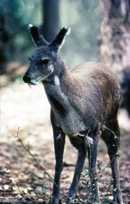
Musk or kasturi obtained from the male deer has led to the wholesale slaughter and near extinction of the Himalayan Musk deer. The extremely odorous substance derived from its musk pod (near its naval), is used as a fixative in expensive perfumes, an ingredient in paan for its aphrodisiac properties, in Ayurvedic medicines, and is utilised for religious purposes by temples.
One musk pod yields no more than 25 grams of musk. And, the international price of musk is about 8 times the price of gold.
The teeth of the musk deer are also prized, as is its meat or venison.
Musk Deer Farming Unsuccessful
Decades back musk deer farms were established by the then Central Council for Research in Ayurveda & Siddha (CCRAS) at three places, but the animals did not bred successfully in captivity. They obviously needed the difficult to obtain musk for their formulations. Despite the failure of the musk deer farms, when in 2016 a 3-month-old male musk deer was found by chance by a rapid response team of the Forest Department, it was introduced in Kufri with the hope of restarting breeding.
One such farm was at Kufri in Himachal Pradesh which was visited by BWC in the late 1970s. The night before the musk was to be extracted the male deer was deprived of food. The next day it was drugged to explore its genital organs and find the musk pod. When located, a cannula was pushed into the area so that the hardened musk granules/grain stuck to it when removed.
The other method utilised was to extract of liquid musk for which the deer was caught, forcibly held down, genitals explored and palpated for the musk which was then painfully scraped out with a sharp knife.
In both procedures, the animals got highly traumatised, panicked and tried to flee. They remained very confused and excited, often jumping high into the air hitting and injuring their heads against the enclosure tops. And many died due to such injuries.
Another similar musk deer farm set up by CCRAS in 1973 was at Pithoragarh, Uttar Pradesh. Musk was extracted once in a decade at this farm following the death of a deer during surgically extracting it. Yet, they got an annual grant of Rs 25 crore. In 2017 the Ayush department under which the farm was functioning said that of the 20 musk deer 3 had died due to unknown causes in just one month, and the farm itself had become non-productive.
The third musk deer farm that was established by CCRAS was at Chamoli, also in Uttar Pradesh. Here too the musk deer did not survive and the 4 that did developed a soil-bound disease.
Despite these grave disasters, in 2002 the Union Minister of Health & Family Welfare proposed musk deer farming in Jammu, Himachal Pradesh and Uttaranchal. BWC immediately sent a detailed protest letter to the Minister, pointing out drawbacks and failings and appealed that they not proceed with such plans.
Around 2005 it was reported that the CCRAS was maintaining a musk deer breeding farm containing 20 animals at Mehroori in Kumaon Hills. It was also reported that musk deer were being bred at their Regional Research Institute of Himalayan Flora, Tarikhet, Ranikhet. In 2012 it was revealed by 4 persons working in this institute that the fertility rate of musk deer was declining and their mortality rate increasing, as also habitual abortions.
|